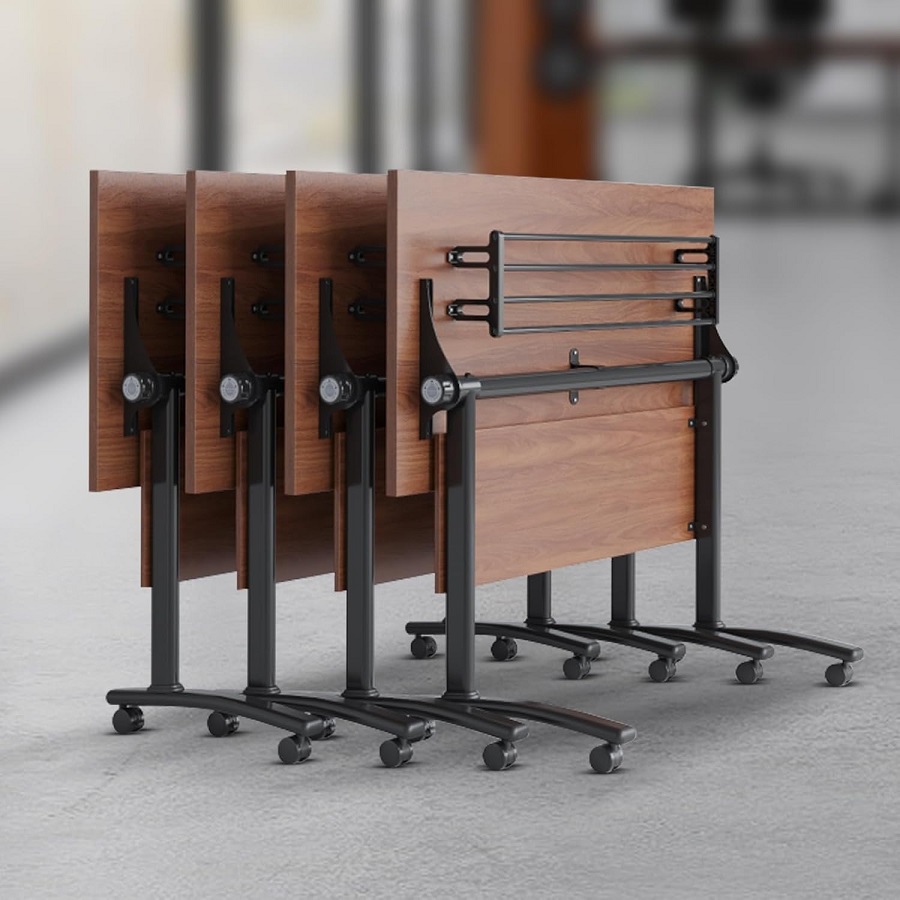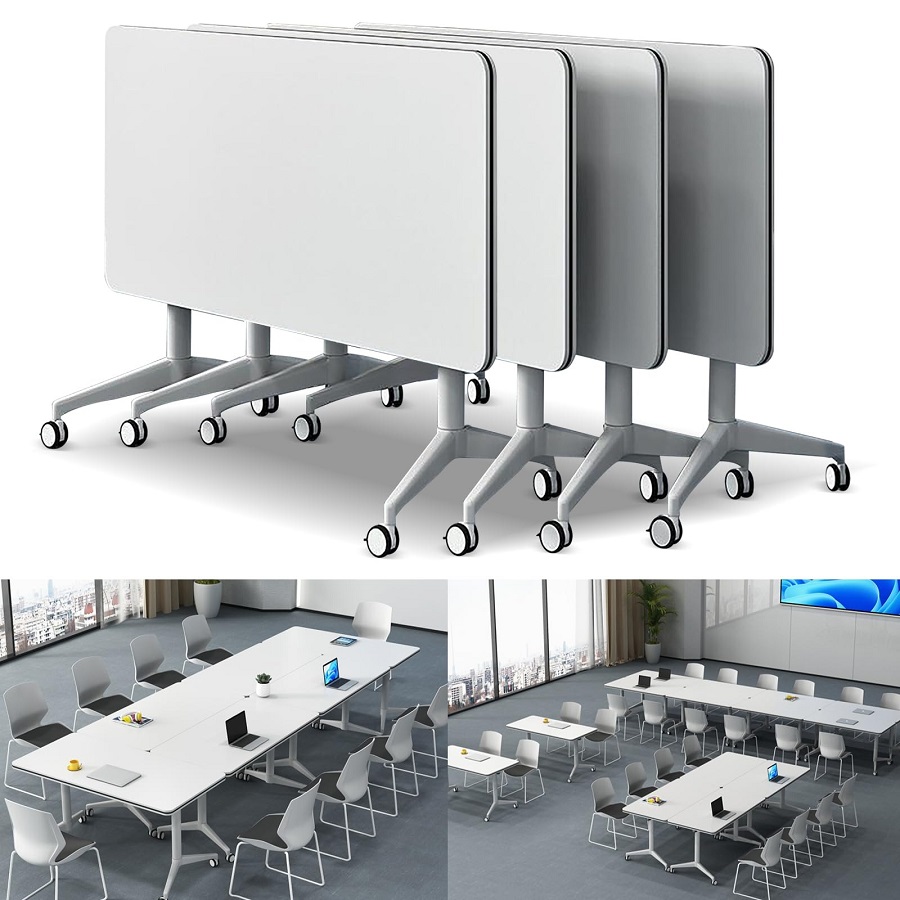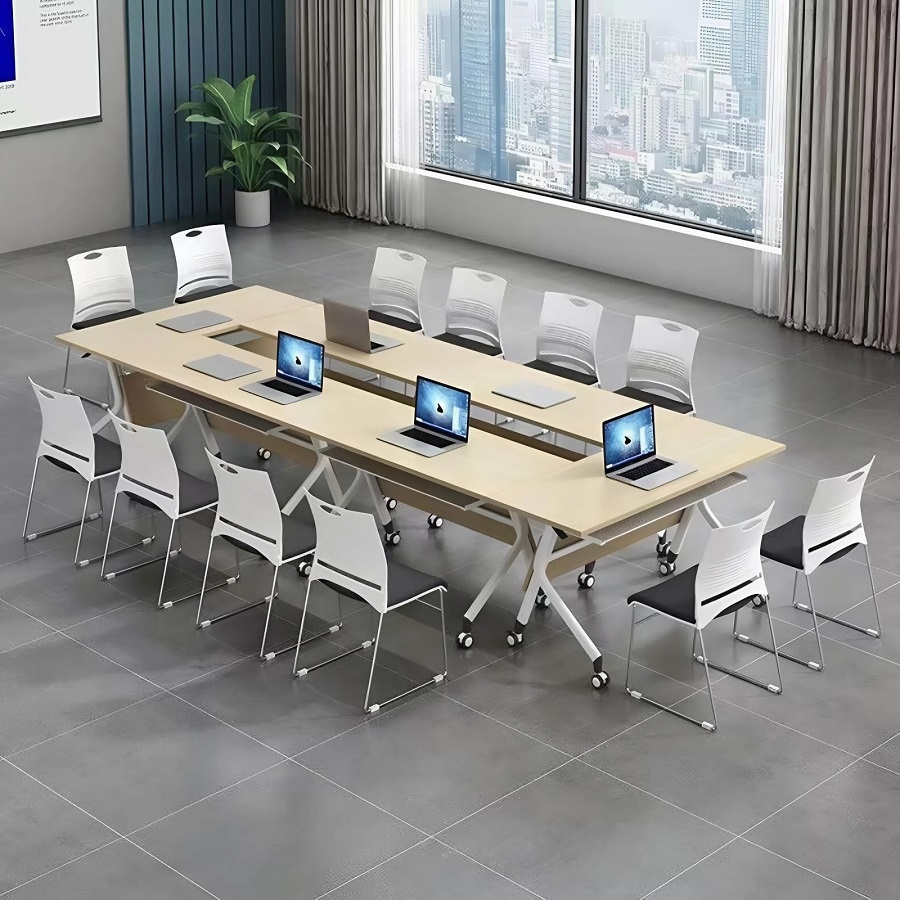The Benefits of Folding Conference Tables
Folding conference tables are an excellent choice for many businesses and event planners. They offer multiple advantages that can significantly enhance the functionality of your space. Here are some of the top benefits:
- Space Efficiency: A major advantage of folding conference tables is their space-saving design. When not in use, they can be folded up and put away, freeing up valuable floor space for other activities.
- Flexibility: These tables are highly versatile, allowing for quick reconfiguration of a room to suit different events or meeting sizes.
- Ease of Transport: Folding conference tables are often designed with mobility in mind. They can be easily moved from one room to another or transported off-site for events.
- Cost-Effective: By owning folding conference tables, you can reduce the need to rent facilities or furniture, saving money in the long-term.
- Quick Setup and Takedown: These tables can be set up and taken down rapidly, which is perfect for hosting back-to-back events or meetings.
- Durability: Many folding conference tables are constructed with heavy-duty materials, ensuring they can withstand repeated use and last for many years.
In short, folding conference tables are not just a practical choice—they’re an intelligent investment for anyone looking to optimize their space and manage it with greater efficiency and ease.

Choosing the Right Folding Conference Table for Your Space
Selecting the ideal folding conference table requires careful thought. Here are key points to consider:
- Measure Your Space: Start by measuring your room’s dimensions. A well-sized table maximizes space without crowding.
- Assess Your Needs: Think about the typical number of attendees and the room’s primary use. Smaller gatherings might need smaller tables.
- Table Shape: Rectangle, round, or other shapes might fit better depending on your layout. Consider traffic flow and room shape.
- Material and Finish: Choose materials that match your room’s style. Durable finishes are key for longevity.
- Portability: Ensure the table is easy to move. Wheels can aid in mobility.
- Ease of Use: The folding mechanism should be simple. Quick setups and takedowns save time.
By carefully weighing these points, you’ll find a folding conference tables that not only fits your space perfectly but also enhances its functionality and flexibility.
Folding Mechanisms: Key Considerations
When deciding on a folding conference table, the type of folding mechanism is crucial. Here’s what to keep in mind:
- Ease of Operation: Look for a table with a mechanism that’s quick and simple. It should be an easy task for one person to handle.
- Safety Features: The mechanism should lock securely in both folded and unfolded states to prevent accidents during use or transport.
- Mechanical Longevity: Choose a mechanism designed to last, withstanding multiple folds without failing or becoming loose over time.
- Maintenance: Opt for tables with mechanisms that are low-maintenance and easy to clean, ensuring long-term use and reliability.
- Compatibility with Accessories: If you plan to use table skirts or add-on sections, the mechanism should accommodate these without issues.
Focusing on these elements will ensure that you invest in a folding conference tables that’s not only practical but safe and durable for frequent use.
Storage Solutions for Folding Conference Tables
Finding efficient storage solutions for folding conference tables is key to maximizing space when they’re not in use. Effective storage not only keeps the tables safe but also maintains accessibility for when they need to be set up quickly. Below are strategies to consider:
- Vertical Stacking: Most folding conference tables are designed to be stacked vertically. This conserves floor area and can help manage inventory.
- Dedicated Storage Area: Assign a specific space within your facility for table storage. Make sure the area is easy to reach and free from clutter.
- Wall Racks or Hanging Systems: Using wall space by installing racks or hanging systems can be a clever way to store tables horizontally and out of the way.
- Protective Covers: Protect your investment with covers that guard against dust and damage during storage. This also keeps the tables clean, saving time before use.
- Mobile Carts: For larger facilities, mobile carts can transport multiple tables at once and serve as a compact storage solution.
- On-Demand Storage Services: If space is at a premium, consider off-site storage solutions that offer on-demand access to your tables.
Implementing smart storage solutions will keep your folding conference tables in top condition, ensuring they’re always ready for your next event while your space remains uncluttered and versatile.

Design and Aesthetics of Folding Conference Tables
When selecting a folding conference table, design and aesthetics are just as essential as functionality. The right style can complement your space, reflecting a professional and welcoming atmosphere for attendees. Consider these points when choosing your table’s design:
- Style Compatibility: Ensure the table’s design aligns with your room’s existing decor. Whether modern or traditional, consistency is key.
- Color Scheme: Pick colors that blend well with your room’s palette. Neutral tones can adapt to various settings.
- Tabletop Finish: A sleek finish not only looks good but can also resist scratches and stains; thus, maintaining a clean appearance.
- Edge Detailing: Attention to details like the edges can impact overall aesthetics. Rounded edges are not only safer but can add a touch of elegance.
- Base Design: The table’s base should be sturdy yet visually pleasing. A well-designed base can hide the folding mechanism and enhance the table’s overall look.
- Branding Opportunity: Customizable options such as logos or company colors can turn the folding conference table into a branding tool.
By focusing on design and aesthetics, your folding conference tables will not only be functional but also serve as a visually appealing element of your meeting space.
Setting Up for Success: Best Practices
The right setup of a folding conference table can greatly influence the success of your event. Here are some best practices to follow:
- Start with a Clean Slate: Before setting up, clean the area. This ensures a neat environment for your set-up.
- Follow a Sequence: Develop a sequence for unfolding and placing tables. This keeps the process smooth and organized.
- Check Stability: After setting up, check each table for stability. A wobbly table can disrupt meetings and cause safety concerns.
- Space Tables Evenly: Create an even layout. Ensure each attendee has enough personal space for comfort and efficiency.
- Secure Cabling: Manage cables from phones, laptops, or projectors. Use clips or grommets to avoid tripping hazards.
- Test Equipment: Check audio-visual equipment before the event starts. Make sure everything works.
- Position for Participation: Arrange tables to encourage interaction. Facilitate eye contact and engagement among participants.
- Plan for Traffic Flow: Leave walking lanes between tables. This allows easy movement and avoids congestion.
- Keep Extra Chairs Handy: Always have additional chairs available. This prepares you for unexpected extra participants.
By adhering to these best practices, you’ll leverage the flexibility of your folding conference table and promote a successful, efficient gathering.

Folding Conference Tables: A Versatile Solution for Various Events
Folding conference tables come into their own in various event scenarios. They prove to be a multipurpose solution whether you’re hosting a business conference, a workshop, or a networking event. Here are a few events where folding conference tables can be particularly effective:
- Seminars and Workshops: Facilitators can easily arrange tables in clusters or rows to foster learning and interaction.
- Networking Events: You can set them up in a stand-up configuration to encourage mingling and conversation.
- Conferences: They can be arranged in theater style for presentations or in a boardroom layout for discussions.
- Training Sessions: Tables can be set in classroom style to accommodate computers and notes.
- Catered Events: They work well for banquets or receptions, offering quick changes between seated dining and standing-room functions.
No matter the function, a folding conference table allows quick adaptation to meet the event’s needs. Remember to always arrange the furniture to enhance the event, maintain clear walkways, and consider attendee comfort at all times. By doing so, you make each event not only functional but welcoming and engaging for all participants.
